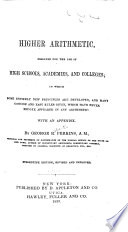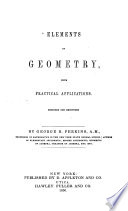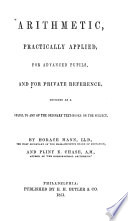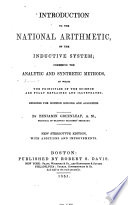 | George Roberts Perkins - Arithmetic - 1850 - 356 pages
...side opposite the right angle is called the hypothenuse. It is an established proposition of geometry, that the square of the hypothenuse is equal to the sum of the squares of the other two sides. From the above proposition, it follows that the square of the hypothenuse,... | |
 | George Roberts Perkins - Geometry - 1850 - 332 pages
...shall have (9+3)x(9-3)=12x6=9 " -3'=81-9=72. PROPOSITION VIII. THEOREM. In any right-angled triangle, the square of the hypothenuse is equal to the sum of the squares of the other two sides. Let ABC be a right-angled triangle, having the rightangle C ; then... | |
 | Roswell Chamberlain Smith - Arithmetic - 1850 - 314 pages
...triangles the longest side is usually considered the Base. 15. In every right-angled triangle, — The square of the hypothenuse is equal to the sum of the squares of the other two sides ; as, 5033 402+302. [Fig. 8.] 16. Hence, to find the different sides,... | |
 | William Smyth - Algebra - 1851 - 272 pages
...of the other two sides ? NOTE. In solving this and other similar questions, it will be recollected that the square of the hypothenuse is equal to the sum of the squares of the other two sides, and the area is equal to one half the product of these sideS. ANS.... | |
 | Horace Mann - 1851 - 384 pages
...measured lines 10ft. apart. This mode of operation is founded on the property of right-angled triangles, that the square of the hypothenuse is equal to the sum of the squares of the other two sides. A roof is said to have a true pitch, when the length of each rafter... | |
 | Jeremiah Day - Geometry - 1851 - 418 pages
...given, the third side may be found, without the aid of the trigonometrical tables, by the proposition, that the square of the hypothenuse is equal to the sum of the squares of the two perpendicular sides. (Euc. 47. 1.) If the legs be given, extracting the square root... | |
 | Edward Deering Mansfield - Education - 1851 - 340 pages
...Pythagoras, in the year five hundred and ninety before Christ, who discovered the fundamental proposition that the square of the hypothenuse is equal to the sum of the squares of the other two sides. Euclid appeared in the year three hundred BC His object was to systematize... | |
 | Edward Deering Mansfield - Education - 1851 - 348 pages
...Pythagoras, in the year five hundred and ninety before Christ, who discovered the fundamental proposition that the square of the hypothenuse is equal to the sum of the squares of the other two sides. Euclid appeared in the year three hundred BC His object was to systematize... | |
 | Charles William Hackley - Trigonometry - 1851 - 536 pages
...last, and a very simple formula depending upon the well-known property of the right angled triangle, that the square of the hypothenuse is equal to the sum of the squares of the other two sides, a formula expressing the value of the sine of half an arc in terms... | |
 | Benjamin Greenleaf - 1851 - 332 pages
...side AC the hypolhenuse, and the angle at B is a right angle. ART. 272. In every right angled triangle the square of the hypothenuse is equal to the sum of the squares of the base and perpendicular, as shown by the following diagram. It will be seen by examining... | |
| |